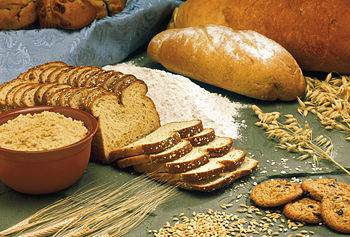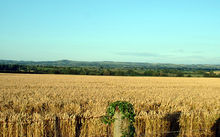Cereal

Cereals, grains or cereal grains, are grasses (members of the monocot families Poaceae or Gramineae)[1] cultivated for the edible components of their fruit seeds (botanically, a type of fruit called a caryopsis) - the endocarp, germ and bran. Cereal grains are grown in greater quantities and provide more food energy worldwide than any other type of crop; they are therefore staple crops. In their natural form (as in whole grain), they are a rich source of vitamins, minerals, carbohydrates, fats and oils, and protein. However, when refined by the removal of the bran and germ, the remaining endocarp is mostly carbohydrate and lacks the majority of the other nutrients. In some developing nations, grain in the form of rice, wheat, or maize (in American terminology, corn) constitutes a majority of daily sustenance. In developed nations, cereal consumption is more moderate and varied but still substantial.
The word cereal derives from Ceres, the name of the Roman goddess of harvest and agriculture.
Production
The following table shows annual production of cereal grains, in 1961,[2] 2005, 2006, and 2007 ranked by 2007 production.[3] All but buckwheat and quinoa are true grasses (these two are pseudocereals).
| Worldwide production in millions (106) of metric tons | ||||
| Grain | 2007 | 2006 | 2005 | 1961 |
|---|---|---|---|---|
| Maize | 792 | 695 | 713 | 205 |
| A staple food of people in America, Africa, and of livestock worldwide; often called "corn" or "Indian corn" in North America, Australia, and New Zealand. | ||||
| Rice[4] | 659 | 635 | 631 | 285 |
| The primary cereal of tropical and some temperate regions | ||||
| Wheat | 606 | 605 | 629 | 222 |
| The primary cereal of temperate regions | ||||
| Barley | 133 | 139 | 141 | 72 |
| Grown for malting and livestock on land too poor or too cold for wheat | ||||
| Sorghum | 63 | 57 | 59 | 41 |
| Important staple food in Asia and Africa and popular worldwide for livestock | ||||
| Millet | 34 | 32 | 31 | 26 |
| A group of similar but distinct cereals that form an important staple food in Asia and Africa. | ||||
| Oats | 25 | 23 | 24 | 50 |
| Formerly the staple food of Scotland and popular worldwide for livestock | ||||
| Rye | 15 | 13 | 15 | 35 |
| Important in cold climates | ||||
| Triticale | 12 | 11 | 13 | 12 |
| Hybrid of wheat and rye, grown similarly to rye | ||||
| Buckwheat | 2.0 | 2.4 | 2.1 | 2.5 |
| A pseudocereal, as it is a Polygonacea and not a Poaceae or Gramineae, used in Eurasia. Major uses include various pancake and groats | ||||
| Fonio | 0.37 | 0.38 | 0.36 | 0.18 |
| Several varieties of which are grown as food crops in Africa | ||||
| Quinoa | 0.06 | 0.06 | 0.06 | 0.03 |
| Pseudocereal, grown in the Andes | ||||
Maize, wheat and rice, between them, accounted for 87% of all grain production, worldwide, and 43% of all food calories in 2003,[3] while the production of oats and rye have drastically gone down from their 1960s levels. Other grains that are important in some places, but that have little production globally (and are not included in FAO statistics), include:
- Teff, popular in Ethiopia but scarcely known elsewhere. This ancient grain is a staple in Ethiopia. It is high in fiber and protein. Its flour is often used to make injera. It can also be eaten as a warm breakfast cereal similar to farina with a chocolate or nutty flavor. Its flour and whole grain products can usually be found in natural foods stores.
- Wild rice, grown in small amounts in North America
- Amaranth, ancient pseudocereal, formerly a staple crop of the Aztec Empire (besides maize)
- Kañiwa, close relative of quinoa
Several other species of wheat have also been domesticated, some very early in the history of agriculture:
- Spelt, a close relative of common wheat
- Einkorn, a wheat species with a single grain
- Emmer, one of the first crops domesticated in the Fertile Crescent
- Durum, the only tetraploid species of wheat currently cultivated, used to make semolina
Farming

While each individual species has its own peculiarities, the cultivation of all cereal crops is similar. All are annual plants; consequently one planting yields one harvest. Wheat, rye, triticale, oats, barley, and spelt are the cool-season cereals. These are hardy plants that grow well in moderate weather and cease to grow in hot weather (approximately 30°C but this varies by species and variety). The other warm-season cereals are tender and prefer hot weather.
Barley and rye are the hardiest cereals, able to overwinter in the subarctic and Siberia. Many cool-season cereals are grown in the tropics. However, some are only grown in cooler highlands, where it may be possible to grow multiple crops in a year.
Planting
The warm-season cereals are grown in tropical lowlands year-round and in temperate climates during the frost-free season. Rice is commonly grown in flooded fields, though some strains are grown on dry land. Other warm climate cereals, such as sorghum, are adapted to arid conditions.
Cool-season cereals are well-adapted to temperate climates. Most varieties of a particular species are either winter or spring types. Winter varieties are sown in the autumn, germinate and grow vegetatively, then become dormant during winter. They resume growing in the springtime and mature in late spring or early summer. This cultivation system makes optimal use of water and frees the land for another crop early in the growing season. Winter varieties do not flower until springtime because they require vernalization: exposure to low temperature for a genetically determined length of time. Where winters are too warm for vernalization or exceed the hardiness of the crop (which varies by species and variety), farmers grow spring varieties. Spring cereals are planted in early springtime and mature later that same summer, without vernalization. Spring cereals typically require more irrigation and yield less than winter cereals.
Period
Once the cereal plants have grown their seeds, they have completed their life cycle. The plants die and become brown and dry. As soon as the parent plants and their seed kernels are reasonably dry, harvest can begin.
In developed countries, cereal crops are universally machine-harvested, typically using a combine harvester, which cuts, threshes, and winnows the grain during a single pass across the field. In developing countries, a variety of harvesting methods are in use,depending on the cost of labor, from combines to hand tools such as the scythe or cradle.
If a crop is harvested during wet weather, the grain may not dry adequately in the field to prevent spoilage during its storage. In this case, the grain is sent to a dehydrating facility, where artificial heat dries it.
In North America, farmers commonly deliver their newly harvested grain to a grain elevator, a large storage facility that consolidates the crops of many farmers. The farmer may sell the grain at the time of delivery or maintain ownership of a share of grain in the pool for later sale. Storage facilities should be protected from small grain pests, rodents and birds.
Nutritional facts
Some grains are deficient in the essential amino acid lysine. That is why a multitude of vegetarian cultures, in order to get a balanced diet, combine their diet of grains with legumes. Many legumes, on the other hand, are deficient in the essential amino acid methionine, which grains contain. Thus a combination of legumes with grains forms a well-balanced diet for vegetarians. Common examples of such combinations are dal with rice by South Indians and Bengalis, dal with wheat by North Indians, and beans with corn tortillas, tofu with rice, and peanut butter with wheat bread (as sandwiches) in several other cultures, including Americans.[5]
Standardization
ISO has published a series of standards regarding the products of the topic and these standards are covered by ICS 67.060 [6].
See also
- Chillcuring, grain ventilating process
- Food quality
- Food safety
- Food price crisis
- Pulse (legume)
- Threshing, process of loosening the edible part of cereal grain
- Winnowing, method for separating grain from chaff
- Zadoks scale
Notes
- ^ The seeds of several other plants, such as buckwheat, are also used in the same manner as grains, but since they are not grasses they cannot strictly be called such
- ^ 1961 is the earliest year for which FAO statistics are available.
- ^ a b "ProdSTAT". FAOSTAT. Retrieved 2006-12-26.
- ^ The weight given is for paddy rice
- ^ Vogel, Steven. Prime Mover – A Natural History of Muscle. W. W. Norton & Company, Inc., USA (2003), p. 301. ISBN 039332463X; ISBN 978-0393324631.
- ^ International Organization for Standardization. "67.060: Cereals, pulses and derived products". Retrieved 23 April 2009.
{{cite web}}: Cite has empty unknown parameter:|coauthors=(help)
External links
- "Home Grown Cereals Authority website". Retrieved 2006-09-08.
- Cereal Recipes
- Cereals by the Vegetarian Society
- Lost Crops of Africa : Grains
